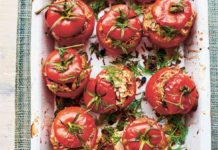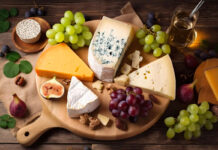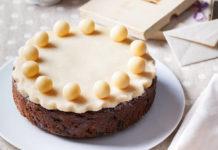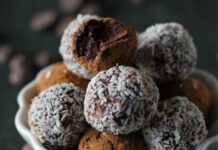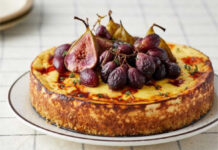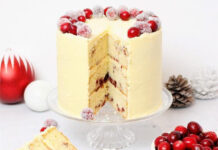Champagne may be the go-to fizz for celebrations, but did you know there’s more to champagne than simply pouring and drinking? We’ve rounded up some of the best tips – from how to open a champagne bottle to answering questions such as whether champagne is best served chilled (clue: yes).
As we all get together with family and friends over festive seasons and New Year, being able to serve and truly enjoy champagne should be high on you (champagne) bucket list.
To get you in the mood for some serious sipping, here’s what you need to know about serving, and drinking, champagne. We’ve included advice on how to open a bottle champagne bottle, how to pour and serve champagne, how to store it and how to choose the right glass for drinking.
There is also a video on how to open a bottle of champagne with pouring and serving advice to help you get the most from your bubbles.
Need more champagne advice? Read the Wise Living guide on how to make cheap sparkling wine taste like champagne.
How many glasses in a bottle of champagne?
Champagne and sparkling wine is typically served as a 125ml measure in small flute shaped glasses. Therefore a standard bottle, which holds 750ml of champagne, will provide 6 glasses of champagne. However, if you are only half filling a flute for a celebratory toast, a 75cl bottle may stretch to 8 glasses.
Essential champagne opening, pouring and storing tips
1. Serve champagne in a ‘tulip style’ glass
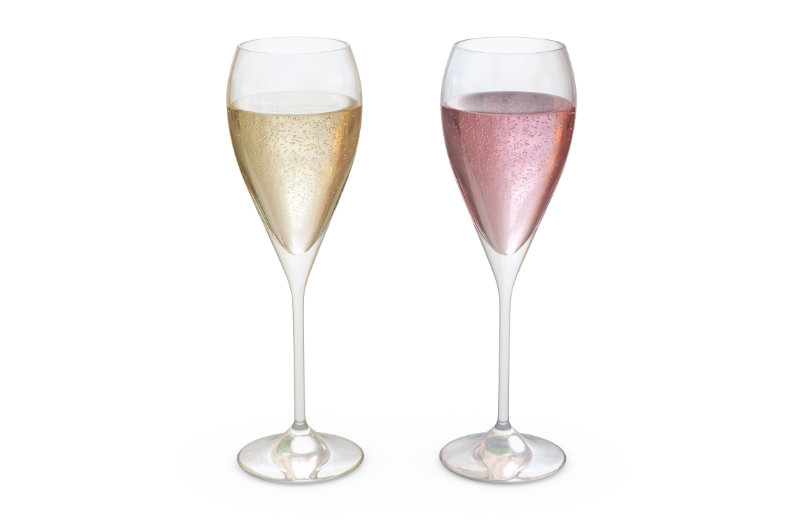
Coupes may look glamorous, but actually the larger surface area of this type of glass causes liquid to lose its bubbles very quickly, meaning the champagne can go flat after a short time.
For the perfect serve, Moët & Chandon recommend using the ‘tulip glass’ – a wider style flute – as it slows down the loss of CO2 and also creates a more intense champagne experience, by enhancing the fragrance on the nose. In the absence of these, traditional flutes are favoured.
2. Champagne is best-served chilled at a temperature of 8-9˚C
For the ultimate serve, Moët & Chandon recommends placing the bottle in a champagne bucket, filling with one-third water and adding ice cubes to top.
Leave for at least 15 minutes before serving to bring champagne to the recommended temperature: 8-9˚C.
3. Don’t store your champagne in the fridge
While champagne is best served chilled, leaving a bottle of champagne in the fridge for long periods could dry its cork out, as there’s no humidity. As a cork dries out, the seal between the bottle and the cork loosens, which speeds up the oxidation process and subsequently changes the champagne’s taste and smell.
Champagne should be kept lying horizontal and avoiding light. Under the stairs works well in the absence of a cellar.
4. Never fill champagne glasses too high
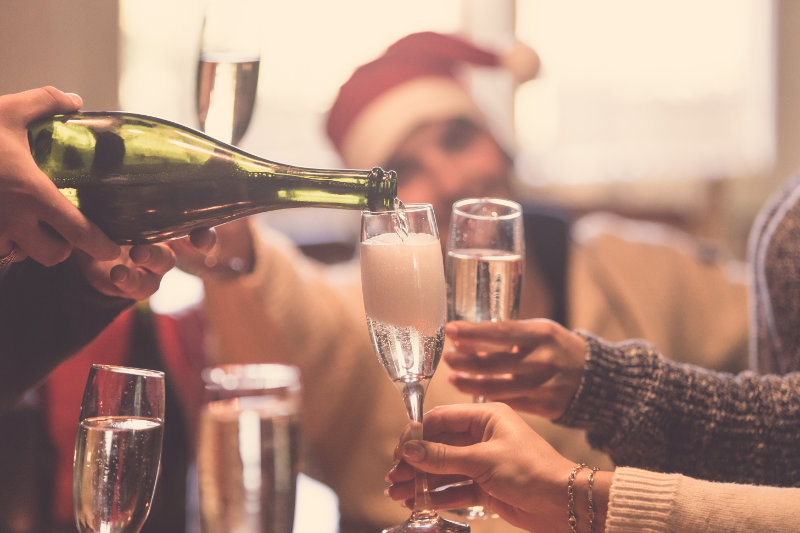
If you’re wondering how much champagne to pour into a glass, the ideal serve for all occasions is to fill the glass two-thirds full of champagne. This ensures the champagne doesn’t warm up before you’ve finished.
5. Champagne cork popping – how to remove a champagne cork
A bottle of Moët & Chandon champagne is opened every second around the globe; the trick for learning how to open a champagne bottle correctly is to firmly grasp the base of the champagne bottle, hold at a 30-degree angle, holding the cork tightly with the cage on and twist from the bottom and tease the cork away from the bottle. The cork should gently ease away with a ‘hiss’ instead of a loud pop.
6. How to hold a champagne glass

Always hold your glass by the stem. This isn’t so you look like an extra in a Hollywood movie – knowing how to hold a champagne glass means you avoid warming the champagne with your hand when cupping the body of the glass. The stem of the flute keeps your body heat away from the chilled champagne.
7. Don’t add ice cubes – with one exception
With traditional champagnes, it’s ill-advised to add ice, as it dilutes the taste rather than keeps it cold, plus, its traditional composition means it will lose its fizz in a cabernet-style glass.
But… thanks to the innovation of Moët & Chandon’s Cellar Master Benoit Gouez, for the first time, you can add ice. Moët was the first in the world to break the champagne taboo and create one specifically created to be enjoyed on the rocks – Moët Ice Imperial (available from Amazon).
It has a heavier composition, which three ice cubes perfectly complement to bring out an intense flavour, even as the ice begins to melt – giving you a refreshing champagne experience.
8. No need to store champange – enjoy immediately
If you’re fortunate to be gifted with an iconic bottle of Moët & Chandon Imperial champagne, or any non-vintage champagne, no need to worry about ageing it further as it’s already been done for you.
9. Champagne and food pairing

Champagne is often served as a pre-dinner drink, or on special occasions such as New Year’s Eve, but it’s the perfect dining companion all year round.
Moët maison’s chef, Marco Fadiga recommends the vibrant, fruity palate of Moët Imperial Rose with strong, bold flavours such as roast lamb; whilst the crisp, clean palate of Moët Imperial works superbly with white fish and white meat. Cheese board to finish?
Ditch the red wine and opt for Moët Imperial with brie and Moët Imperial Rose with goats cheese.
10. Don’t just enjoy champagne at celebrations
Champagne is made for sharing amongst friends, from festive celebrations to weddings, it’s the ultimate curator of unforgettable and shareable moments.
Enjoy champagne as part of your everyday celebration; even if it’s just toasting a well-deserved weekend!
Looking for cheap champagne? Read the Wise Living round-up of the best cheap champagne, Prosecco and sparkling wine deals.
How to open a champagne bottle
It takes a skilled grip and some handy knowledge to know how to open a champagne bottle. Unlike wine, there are no tools of the trade, no go-to professional corkscrew or fool-proof gadget so you don’t botch it.
Nope, when it comes to sparkling wine the pressure is firmly on the person handling the bottle. And what we want to hear is a graceful hiss rather than a loud pop, the latter of which unfortunately leads to a gush of foam, spilt bubbles and disappointment – especially when those precious bubbles usually mark a special occasion and don’t come cheap.
Here’s how to ensure you know how to open a champagne bottle and master champagne cork popping.
11. Champagne is best served chilled
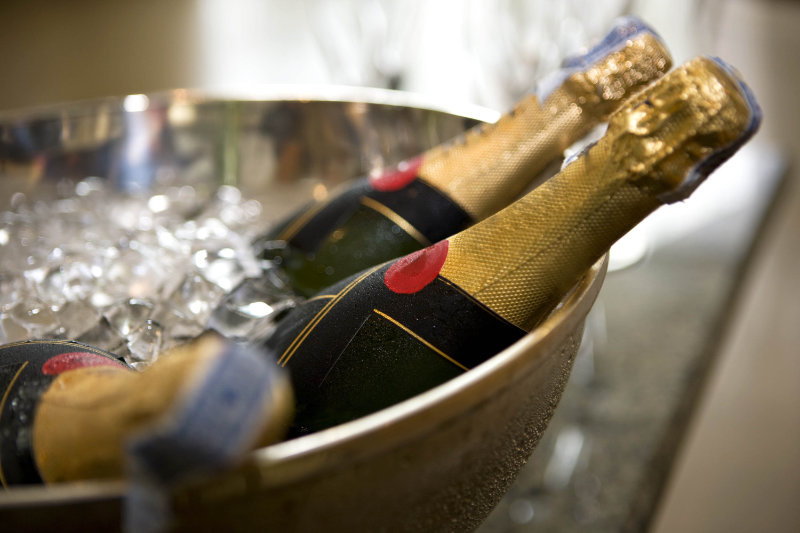
Make sure the bottle is perfectly chilled before you even attempt to open it. The ideal temperature for serving champagne is 8-10°C. If it isn’t cold enough, the pressure inside the bottle will cause the cork to explode and leave your friends diving for cover.
12. Don’t rely on the tab to open the foil
Champagne producers want to make life easy for us, but sometimes the tab on the foil doesn’t pull back and gets messy when you try to peel it off. Instead, reach for back-up and use a blade to remove the foil covering the cork, to create a clean line.
13. Keep the wire cage on when champagne cork popping
Safety comes first. The cage keeps the cork in place, so it’s important to keep your thumb on it while you loosen the cage but don’t remove it. From the moment the cage is released, there’s always the chance the cork could go flying, so don’t point the bottle at anyone and keep it at a 45-degree angle.
14. Twist the bottle, not the cork

Once the cage is loosened, with one hand on the cork and the other firmly on the bottle, start to rotate the base of the bottle while keeping a tight hold on the cork and cage. This is one of the key techniques for how to open a champagne bottle. Keep twisting until the cork starts to ease out gently with the bottle pressure. The slower the cork is released, the more gentle the hissing sound.
15. Don’t wave the bottle in the air
Once you’ve popped the cork, keep the bottle at a 45-degree angle for a couple of seconds so the fizz doesn’t spray all over the place (save the theatrics for the winners’ podium) and then slowly pour it.
16. Don’t serve it in a flute
An elegant crystal flute may look the part, but any sommelier will tell you sparkling wine tastes better in a white wine glass. The aromas and flavours are far more expressive when you sip from a thin-rimmed glass that’s rounded in the middle, rather than a narrow flute which inhibits the nose and structure of the wine.
How to choose the right champagne glass
You may be surprised to know that no matter how much you splash out on that celebratory bottle of bubbly, to appreciate champagne properly, you need to serve it in the right shaped glass. And that, you might be surprised to learn, isn’t a champagne flute.
To get the most from your fizz, we’ve hooked up with one of the country’s leading experts in sparkling wine, Davy Zyw, author of 101 Champagnes And Other Sparkling Wines To Try Before You Die (available from Amazon), to guide us through his glass know how…
How to pour champagne (and which glass to use)
“The shapes and sizes of glasses have shifted, following changes in drinking status, trends and fashions, and with an improved understanding of the flavour of champagne,” says Zyw.
“Generally speaking, champagne glasses are designed to enhance and accentuate a particular organoleptic [involving the senses] quality found in wine, while keeping your hot hands away from the liquid, to avoid warming your delicately cooled champagne. This is why wine glasses have long stems.”
Zyw shares six fizzy facts to enhance those sparkling occasions…
17. Shape
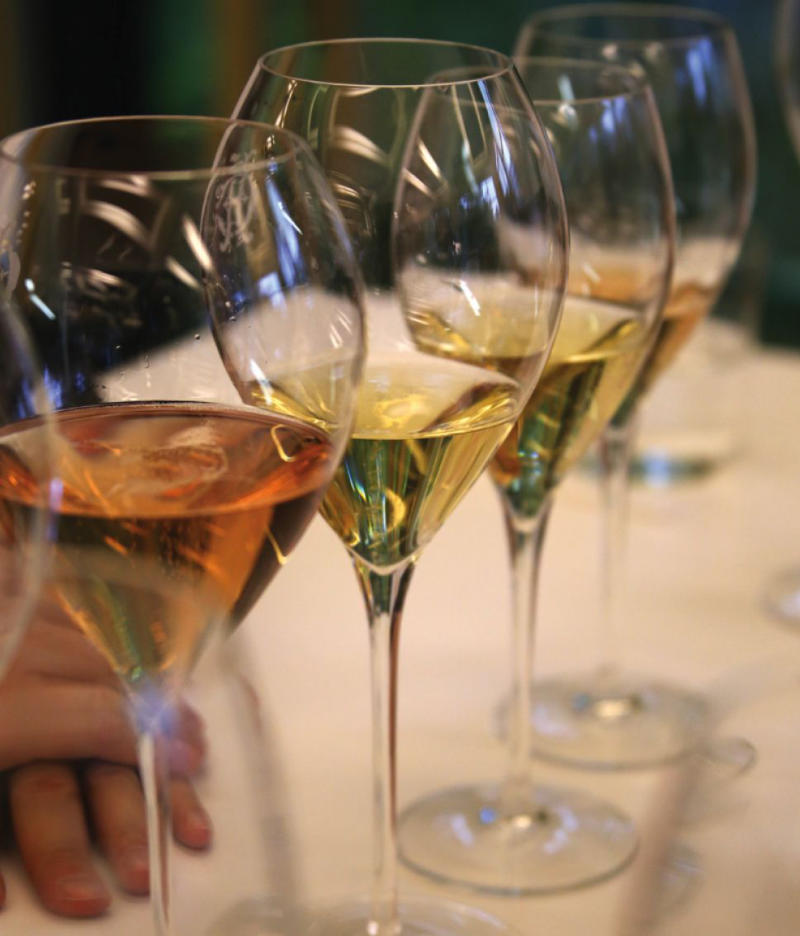
The shape of the glass will channel aromas and smells in the right direction, i.e. up your schnoz. The shape will also dictate the persistence and display of bubbles; the narrower and taller the glass, the smaller the ratio of air to wine, keeping those cheeky bubbles alive for longer.
18. Ciao ciao, coupe!
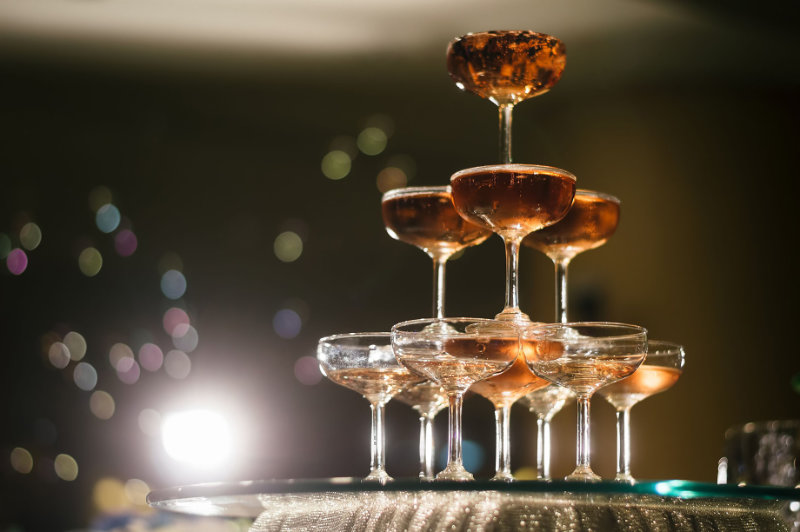
The most famous of champagne’s glasses has to be the shallow coupe, said to be modelled on the breasts of France’s queen Marie Antoinette. Although this glass was actually created specifically for sparkling wine in England in the 1690s, I still like to think Marie Antoinette’s desirable bosom had a part to play in the design.
The coupe became hugely popular in the UK, the States and Russia, glamorised by champagne houses, including Veuve Clicquot. The problem with the coupe glass is that it’s too short and too wide. Once poured, the champagne goes flat a little too quickly.
19. Farewell to flutes!
Flutes are popular because they showcase the tiny, gently rising bubbles up the sides of a tall, narrow glass, thus continuing champagne’s visual appeal. The best flutes have etching in the bottom of the glass to act as a nucleation point for the steady, even stream of bubbles. Another major plus for the flute is that it’s much harder to spill your precious fizz out of the glass.
But although flutes are visually pleasing, they do not best showcase the quality of champagne in the glass; in fact they impede it. They are fine for simple fizzers at parties, but if you have a special bottle you want to savour, then flutes will literally restrict the flavour.
20. A normal wine glass is better than a flute
Like fine wine, a certain amount of oxygen is needed to open and aerate the aromas and flavours of champagne. The shape of the flute inhibits the style, and can hide the taste. I’m happier drinking my champers out of normal wine glasses, so I can fully appreciate the aromas and tastes released in the glass. I recommend you follow suit.
21. Time for the tulip glass
With the shift away from flutes and coupes, many of the top champagne houses have devised bespoke glasses for their own top cuvées (the blends). The result is a tulip-shaped glass which offers the best of both flutes and wine glasses.
The shape of the tulip glass gives more air to the surface of the champagne, thus allowing more of the fizzy aromas to escape, then cleverly tapers around the rim to allow each one of the bubbles to burst simultaneously at the glass’s widest point.
So, when you stick your nose in for a whiff, you get maximum flavour and aromas from the bursting champagne bubbles. BOOM!
22. Show respect
Many sparkling wines, especially champagnes, have taken years or decades to make. It would be a shame to undo all that time in a few seconds by using the wrong vessel or not knowing how to open a champagne bottle. So, next time you pop a cork, do yourself a flavour favour and use a proper glass and pop your cork correctly.
Best-selling champagne flutes
Stuck for inspiration? Check out our list of best-selling Amazon products!
- Classic shaped glassware from Argon Tableware. Perfect for homes as well as bars, restaurants and pubs. 10% dishwasher safe.
- The reinforced base is sturdy enough to suit both the home and professional establishments alike, while a soft rolled rim offers additional resistance against chipping if knocked or dropped.
- Provides the perfect serving solution for drinks! These glasses are 100% Dishwashers safe.
- Brand: simpahome
- Set of 12 Crystal Glass Champagne Flutes 230ml - Cristallin Crystal Glass - 21.5cm (H) x 4cm (Rim Diameter) Dishwasher Safe
- Size: 12 Count (Pack of 1)
- [Set of Four Artisanal Flutes] Discover the grace of the Katie Jayne ‘Tulip’ set, featuring four mouth-blown champagne flutes, each embodying the pinnacle of craftsmanship and luxury.
- [Designed For Effervescence] The narrow shape of each flute is purposefully designed to maintain the effervescence and aroma concentration of your champagne or prosecco, elevating every sip.
- [Exquisite Craftsmanship] Mouth-blown with skill, these flutes exemplify elegance and quality, making each sip a truly sophisticated experience.
- CRYSTAL CHAMPAGNE GLASSES: Add a retro touch to your drinkware with this elegant set of champagne flutes, perfect for indulging in your favourite bubbly. The narrow shape is designed to enhance the...
- IDEAL FOR SPECIAL OCCASIONS: Ideal for weddings, parties or themed events, these champagne glasses exude vintage glamour. Reminiscent of art deco glasses, the design recreates the elegance of the...
- CHAMPAGNE GLASS GIFT SET: Whether gifting to a champagne enthusiast or a lover of vintage aesthetics, this set has you covered. Beautifully presented in an RCR branded box, it's the ultimate gift for...
- 【More Bubbles, More Enjoyment】Due to the unique design, it helps preserving bubbles in your champagne and the bubbles will tingle your nostrils and you've got the whole sensory experience while...
- 【More Glasses, More Chilling】Hold about 145 mls when brimfull, this means you get more glasses per bottle, even better is you can always drink cool champagne.
- 【More Solid, More Stable】Made entirely of clear glass, the base is a thick solid piece of transparent glass to help weigh it down and keep good balance
Last update on 2024-03-29 / Affiliate links / Images from Amazon Product Advertising API
You may be interested in…
This article may include affiliate links to products and services where we may receive a small fee to support the running of this site if you make a purchase or is a sponsored article from one of our select editorial partners providing valuable advice and information to our readers.





























































